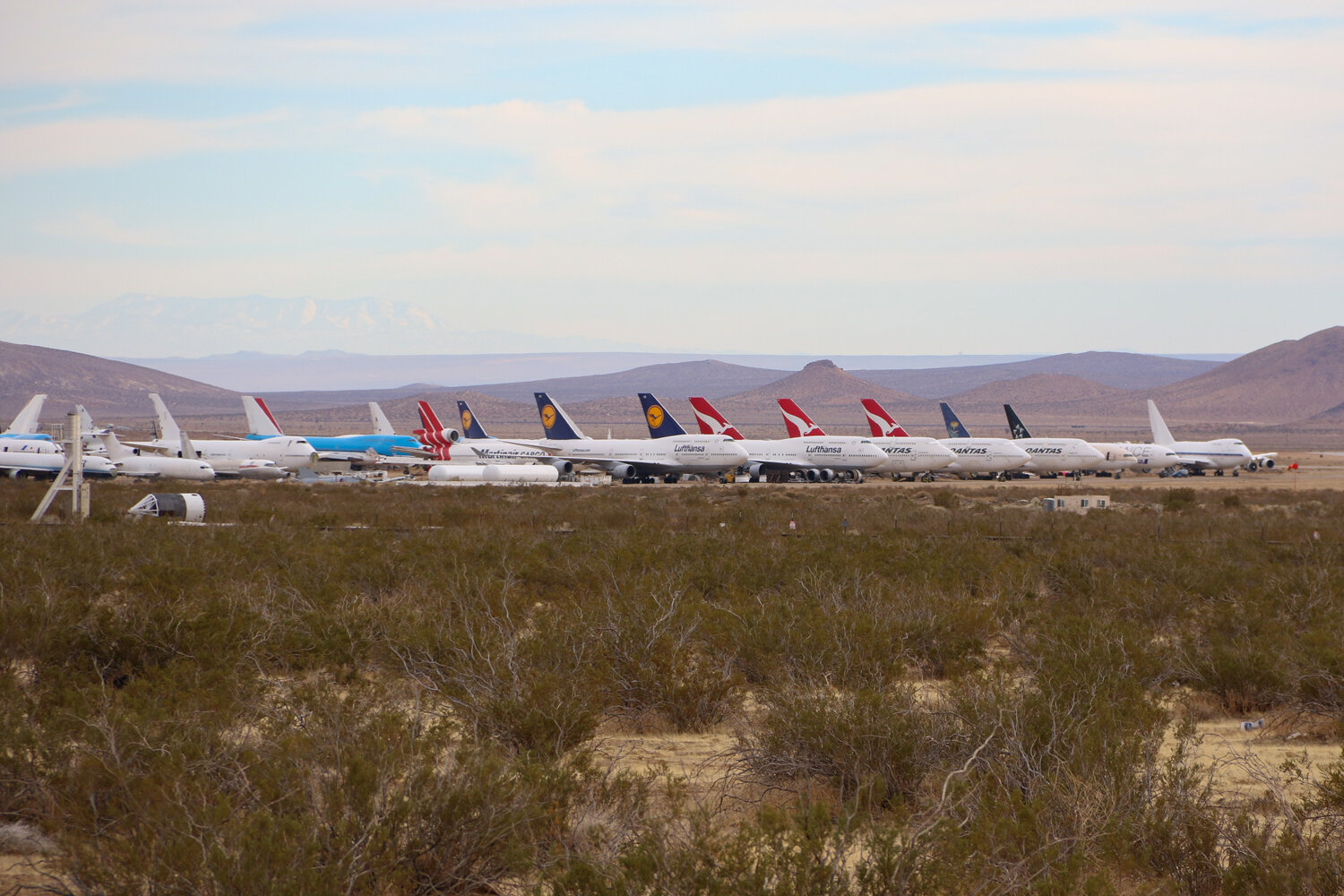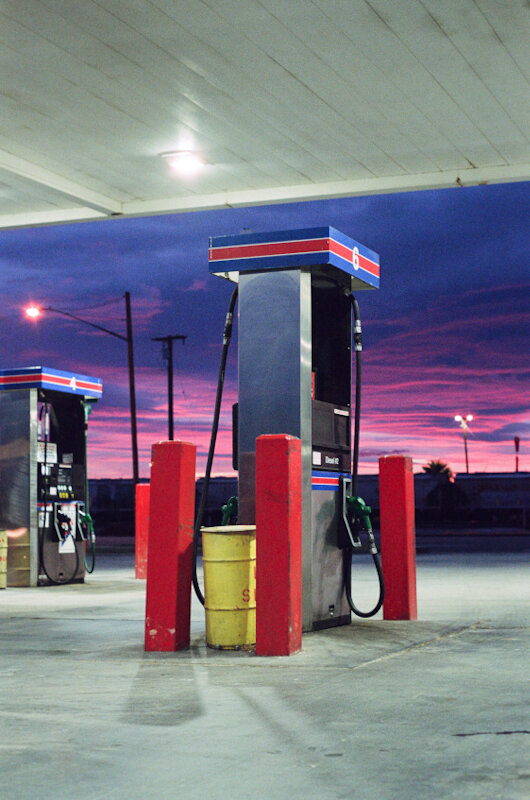California City
Lamont Odett Vista Point in Palmdale as seen on the way to California City from Los Angeles.
Canon AE-1 + Ektar 100
It would be incredibly difficult to capture the full story of California City in one web post. Even if I did go to the distance to write it all out, I doubt I could tell the tale as well as journalist Emily Geurin already has. It was her podcast series from LAist Studios and Southern California Public Radio that drew me in week after week. And it was also that series that inspired me to snag a rental car and make the 1.5 hour drive from Los Angeles.
I can’t recommend the podcast enough, but I also realize that for the sake of this post, some context is needed. So, without giving too much away (because the entire series is truly well worth a detailed listen), here’s a quick synopsis:
What’s known today as California City has its roots in the continent’s colonial past. Originally a camp for Franciscan missions, the area became an industrial waypoint as the Twenty Mule Team passed through with loads of borax on their way to the railroad in nearby Mojave, CA. By the mid-20th century, an entrepreneur by the name of Nathan “Nat” K. Mendelsohn sought to develop the area into a planned community that might one day rival Los Angeles. Mendelsohn purchased thousands of acres and constructed amenities such as a grand central park, multiple golf courses, and lavish public buildings designed by famed architects. His vision was fueled and financed by land speculation. Essentially: numerous plots of land were sold to speculators who were given property that could (or, rather, were advertised as “would”) one day be worth a great deal as the town grew. Over time, though, the dream of California City was barely realized. Even after Mendelsohn was out of the picture, the “land banking” scheme continued under various organizations with plots being sold via infomercials and arranged trips of potential investors to the town. Aggressive sales tactics and allegations of fraud marked the project and its various promoters from the beginning. Famed consumer advocate Ralph Nader and “Nader’s Raiders” even once tried to stop the California City land sale programs. However, various schemes would continue to toe the legal lines well up and into the 21st Century. The story of those personal, legal, and financial ramifications is still playing out today (as expertly reported on in the aforementioned podcast). What’s left are various structures of the city’s once grand vision such as a central park with a dried up waterfall and weed choked pathways.
When I arrived, I was surprised to find the city wasn’t as desolate or remote as I had imagined when listening to the audio stories. The nearby town of Mojave with its interstate and railroad connections isn’t too far away and California City itself features the usual American trappings of fast food and strip malls. While much of the surrounding desert is a hotbed for motorsports, these long stretches of barren landscape are also where the area’s history sets in. This is where one finds the roads to nowhere, denoted by modern street sights and laid out like an atypical community, but completely void of homes and people. Still, if one were to pass through unaware of the area’s sordid past and history of financial swindling, the town might seem like any other aging exurban community. That’s where the podcast comes in and brilliantly shines a light on the full scope of the area’s story.
So, after listening and finding myself in Los Angeles, I made the drive and made the following photographs.
Mojave Air & Space Port commercial airliner graveyard en route to California City.
Digital
California City West Way Station rest area along California City Blvd just outside the town.
Canon AE-1 + Ektar 100
California City Blvd.
Canon AE-1 + Ektar 100
California City Blvd
Canon AE-1 + Ektar 100
One of California City’s many undeveloped roads.
Canon AE-1 + Ektar 100
Aircraft graveyard at the California City Airport.
Canon AE-1 + Ektar 100
Canon AE-1 + Ektar 100
Digital
Canon AE-1 + Ektar 100
Canon AE-1 + Ektar 100
Canon AE-1 + Ektar 100
Canon AE-1 + Ektar 100
Canon AE-1 + Ektar 100
An undeveloped road, denoted by a modern street sign, meets the paved road to the single runway California City Airport.
Canon AE-1 + Ektar 100
The intersection of the developed Mitchell Blvd. and undeveloped Margery Ave. as denoted by modern street signs. Arid lands in the background are undeveloped lots once for sale.
Canon AE-1 + Ektar 100
Crumbling building on the shores of the Central Park Lake.
Canon AE-1 + Ektar 100
Central Park Lake.
Canon AE-1 + Ektar 100
Recreation structure at Central Park Lake.
Canon AE-1 + Ektar 100
Structure at Central Park Lake.
Canon AE-1 + Ektar 100
Dried up waterfall and abandoned bridge in Central Park.
Canon AE-1 + Ektar 100
Atop the dried up waterfall in Central Park.
Canon AE-1 + Ektar 100
Abandoned bridge in the city’s Central Park.
Canon AE-1 + Ektar 100
Crumbling bridge structure in the city’s Central Park.
Canon AE-1 + Ektar 100
A more basic street sign denotes two undeveloped roadways on the outskirts of California City.
Pentax K1000 + Portra 800
Advertisement for the Silver Saddle Ranch & Club’s Galilelo “LandBanking Plus+” Project. The club and its projects were at the center of LAist Studio’s California City podcast.
Pentax K1000 + Portra 800
Entrance to the Silver Saddle Ranch & Club. Now closed, the club and its controversial real estate practices were highlighted in the LAist Studio’s podcast California City.
Pentax K1000 + Portra 800
Deteriorating strip mall.
Pentax K1000 + Portra 800
Gas station in Mojave, CA on the way out of California City.
Pentax K1000 + Portra 800
Liquor store and motel in Mojave, CA as seen while departing the California City area.
Digital
The above is post 4 of (eventually) 6 featuring photographs made while traveling to, in, and around Los Angeles.





























